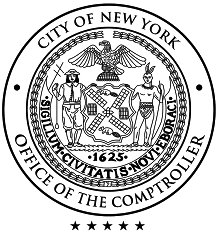
Image Credit: Office of the Comptroller
Recommendations include increasing affordable housing near subway stations and increasing service on subway routes and high-ridership bus routes. On October 10, 2021, Comptroller Scott Stringer released “Beyond Rush Hour: COVID-19 and the Future of Public Transit,” a new report reviewing changes in public transit ridership due to the pandemic.
The transit data collected from MTA shows that subway ridership is still at 50 percent below pre-pandemic levels and bus ridership is down 40 percent. Changes in ridership varied by borough; from 2019 to 2020, subway ridership in Manhattan dropped by 66 percent while in the Bronx it dropped by 53 percent. Changes in ridership also depended on the time of day; while most times of day saw around a 60 percent drop in subway ridership, the early morning hours of 5 to 7 AM only saw a 48 percent drop. This difference was explained by the greater number of essential workers that need to commute during that time frame. Weekend ridership has recovered at a faster rate than weekday ridership, with weekend ridership now at 65 percent of pre-pandemic levels. Overall, the changes in ridership have resulted in a $2.9 billion drop in revenue from fares.
Other data showed a difference in the types of jobs between Manhattan and other boroughs. According to the report, 61 percent of jobs in shift work or service industries (including food, healthcare, retail, personal services and other businesses) that are more likely to require in person interaction are located in the outer boroughs, but 89 percent of jobs that are more compatible with remote or hybrid work (finance, tech, media, insurance, other professional services) are located within Manhattan. Only 16 percent of the people who work in shift work or service industries live in Manhattan. As a result of this data, the report reflects that “New Yorkers working in these service, shift work, face-to-face industries generally do not abide by the standard 9am–5pm, Monday-to-Friday schedule and will often live and work in the non-Manhattan boroughs. These scattered commuting arrangements rarely conform to the hub-and-smoke subway system, requiring long, slow, early-morning, meandering bus rides to get to work, as well as off-peak subway trips with several transfers.”
Comptroller Stringer’s recommendations were shaped by this data to better serve more of the populations citywide that rely on public transit. Comptroller Stringer’s recommendations include:
– Implement the “New York City in Six” service plan, which would increase subway and high-ridership bus lane frequencies to a minimum of six minutes throughout the day. Current standards all for a minimum of ten minute frequencies midday and twelve minute frequencies on evenings and weekends. Increasing frequencies on high-ridership bus routes would improve transit access, especially during early morning hours when buses can sometimes only appear once every 30 minutes.
– Change fares for in-city trips on commuter rail lines to the price of a subway or bus ride, and make transfers between commuter rails, subways and buses free for in-city and suburban commuters.
– Add 35 miles of dedicated bus lanes and busways per year.
– Add affordable housing near existing subway stations and extend rail lines. The Comptroller recommends rezoning and subsidizing the development of deeply affordable housing in residential areas near subway stations with less than 5,000 daily riders to incentivize people finding housing with easy subway access.
– Reopen closed subway entrances to improve access to stations, including a five-year plan to reopen all closed entrances by 2027. Currently, more than a hundred of the City’s stations have at least one street-level entrance that has been permanently closed.
– Increase the gas tax within the 12-county Metropolitan Community Transit District, with about two-thirds of the revenue from the gas tax dedicated to public transit investment.
– Have the State Legislature pass a law similar to Washington State’s Commute Trip Reduction law which requires worksites with 100 or more employees to survey employees and submit commute trip reduction plans, and incentivize commuting via more sustainable modes of transportation. Comptroller Stringer says the City should create a task force with the goal of reducing car dependency and increasing public transportation ridership.
– Congress should pass the “Stronger Communities Through Better Transit” Act, which would provide $3 billion to the MTA annually and help make up for revenue losses.
To read the full report, click here.
Comptroller Stringer stated, “The data is clear: the new rush hour is around the clock—and we need to reform our outdated transit system to meet people when and where they are in a post-pandemic economy. Frontline workers and New Yorkers in face-to-face jobs can’t afford to wait endlessly at platforms and bus stops for trains and buses that never come. If we want to reduce congestion and encourage people return to public transit, we need to invest in changes that make public transit an accessible and convenient option for every commuter at every time of day.”
By: Veronica Rose (Veronica is the CityLaw fellow and a New York Law School graduate, Class of 2018.)

